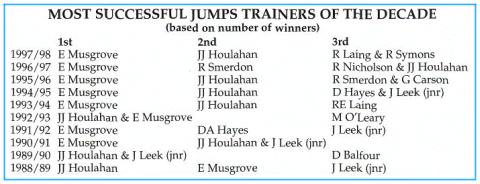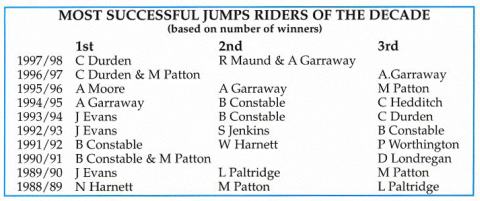In this two-part article, Paul Bockman, one of Australia's leading jumps racing form analysts, discusses the key form factors he uses to beat the jumps.
WHY THE JUMPS?
Intelligent people often ask me: "Why specialise in jumping races? It's too risky!" They comment on the cash they once lost when their selection - a certain victor - lost its rider at the last jump. It seems that punters have vivid memories about such spectacular losses. But those punters also tend to forget many less spectacular losses on the flat.
From a purely punting angle, the occasional mishap over jumps is no different to a galloper in a sprint race being slightly checked or blocked for a run and losing all chance of winning.
The mental angle of seeing a jumper lose its jockey, and thus your betting dollar, is far more significant than the regular sight of a sprinter on the flat being caught wide in a packed field. Both have the same result for the gambler!
Checks and blocked runs are often not significant in a long distance jumping event. Smaller fields and plenty of time to recover from a check make jumps horses less likely to lose due to bad luck in running.
This is a balancing factor in favour of jumps racing that most punters ignore. Due to the potential for spills, jumps racing is viewed as a riskier punting proposition than flat racing. Successful jumps punters have proven this to be a fallacy.
FORM STUDY
The beauty of jumps racing is that there is plenty of form to study on each runner. In Australia, most horses take to the jumps after racing extensively on the flat. Therefore, each horse has a bank of form information just waiting to be studied by the keen student. This form history provides excellent clues about a racehorse's strengths and weaknesses.
To 'beat the jumps' from a punting angle, the punter must learn to understand a horse's flat form, and to apply it to jump racing. This is not simple, because apart from the actual obstacles, jumps races are very different to their flat counterparts. Hurdle and steeplechase races are usually conducted over longer journeys, with different jockeys and a much higher weight scale. The challenge is to consider these new variables and translate them into winners.
TRAINERS
The trainers who prepare leaping horses comprise a small subset of those who train flat-race gallopers. This is primarily due to the geographic location of jumps racing being restricted to only Victoria, Tasmania and South Australia. In the 1997/98 racing year, there were only 25 trainers in Australia who prepared more than three winners over hurdles and steeples. This select group of trainers forms the backbone of jumps racing. The table below highlights the long-term supremacy of the master jumps conditioners, Eric Musgrove and Jim Houlahan.
Eric Musgrove has revitalised former classy 3yo wet-tracker and miler Palace Symphony into arguably the best steeplechaser in the land. A special watch should be maintained by punters when the Musgrove stable takes a
runner over to South Australia. The Musgrove win-strike rate is extremely impressive.
Jim Houlahan has dominated the VRC Grand National Hurdle with an incredible six of the last nine winners. His success stories have included champion jumper Sharp As and the most recent winners, Angler Parade and Moon Chase. Houlahan is a role model, particularly in 1999, the Year of the Aged person. Even as an octogenarian, his small but elite stable continues to prepare feature winners over obstacles and his continuing high strike rate is a
punters' delight.

THE HANDICAPPER
Weight is crucial in jumps racing because hurdlers and steeplechasers have to lift their allotted weight over each obstacle, as well as carry the weight on the flat. This vertical and lateral weight lifting (usually over long distances) makes it tough for most jumping horses to win carrying handicaps high above the limit weight.
During the 1997/98 racing season, not a single metropolitan event was won by a jumper carrying 8kg or more above the minimum weight! Conversely, often a horse that has carried a large handicap weight to win over jumps will be able to repeat the performance with slightly more weight.
I give these rare gallopers a mental "weight exemption" when they have proven their superior strength and stamina under big weights. Sir Agrifo, Hip Flask, Sharp As and the Casterton steeplechase specialist Burkhill's Lane are examples of some gallant weight-carrying jumpers of the past decade.

JOCKEYS
There is a courageous, skilled band of horsemen who ply their craft, flying over the brush, for around $150 per losing ride. Undoubtedly they ride for reasons deeper than financial gain. The pool of jockeys riding over jumps is much smaller than that registered to ride on the flat. Clearly, this is due to jumps racing being conducted only in Victoria, Tasmania and South Australia.
It also has a lot to do with the fewer opportunities available for race rides, given that there are usually only one or two jumps races per meeting. Whilst there were only about 60 jockeys riding over jumps last season, the cream certainly rises to the top. Statistics from the 1997/98 season indicate that Craig Durden guided home the most winners with a strike rate of 17 per cent.
TRACK CONDITIONS
I find that in most cases a horse's ability to excel or flounder over jumps in rain-affected going remains consistent from its flat racing career. Hence, when a flat race horse makes the transition to jumping, it is worthwhile studying its history on wet tracks. Of course, rain-affected tracks can also sap a horse's stamina over longer journeys. This is not so much related to whether a horse handles wet tracks, but more to a horse's staying ability.
BREEDING
Gallopers find their way into the jumps scene from diverse areas. Some are earmarked for a jumping career from a young age and others are purchased specifically after flat race careers in Queensland, NSW or WA. Breeding can be quite varied and, interestingly, some incredibly well-bred geldings have raced with good success over jumps in Australia. Several Zabeel geldings are now hurdling, and the noted jumping pair Tembo Tembea and Hip Flask are both by super sire Sir Tristram.
From a punting viewpoint, I place little emphasis on the breeding of hurdlers. By the time horses commence a jumping career, it is usually well established whether they can stay over a middle-distance on the flat. The first hurdler I owned was by the speed machine Luskin Star. He won jumps events over 2800m and 2950m.
DEBUT RUNNERS OVER HURDLES
I tend to be cautious when considering the prospects of a horse having its initial attempt over hurdles. On debut, I only consider horses being prepared by well-credentialled trainers, and carrying capable jockeys. The problem here is that more often than not these debut hurdlers are sent out at cramped odds. Some of them display an efficient hurdling style and run well, and others are not suited to jumping and run like crabs.
I prefer to watch the debut runners have a go first and assess their futures after the race.
Another plank supporting this argument is that horses often improve greatly at their second jumps run.
Perhaps you remember Bright Spot's debut over jumps in April 1998? He was well supported, based on his Group 3 flat form in dead-heating with Vita Man in the 1997 Queen Elizabeth Stakes. On hurdle debut, at his favourite Flemington track, Bright Spot was a costly 6/4 favourite and was probably unlucky when 3rd to handy hurdlers Century Fox and Academy Beau.
Connections spelled him and on his return to hurdling in the spring of 1998, Bright Spot won three of his next four starts, including an 8length Bendigo win. This sequence culminated with a stunning victory in the X~ p feature 1998 Melbourne Cup Hurdle.
STEEPLECHASE DEBUT
The exception to the 'debut' rule is when hurdlers make the transition to the larger steeplechase fences. When attempting the large fences for the first time, hurdlers tend to skim the big brush fences and jump extremely efficiently.
Often, as steeplechasers become more seasoned, they lose some of their pace on the flat and also tend to respect the big fences more and jump a little higher, in the process losing that key speed edge.
The 'Cox Plate' of steeplechasing, the A.V Hiskens Steeplechase at Moonee Valley, has been won many times by a first-timer over fences (but not obstacles). In 1998 the ultra-consistent John Wheeler trained hurdler Maybe Rough maintained this occurrence by beating Moon Chase, another steeplechase newcomer.
DISTANCE RANGE
There is an abundance of theories about why many horses can handle the longer distances over hurdles when they have been unable to do so in many flat-racing attempts. It is fatal to restrict your jumps punting to horses who have been successful over equivalent distances on the flat. Many true stayers on the flat lack the mid-race acceleration to win over jumps.
On the other hand, true sprinters on the flat are unlikely to conserve enough stamina to be successful over jumping distances of 2800mplus. They often pull hard and refuse to settle when racing over longer jumping journeys. When studying the form for punting opportunities over the jumps, I look for a galloper who has won over 1600 to 1800m on the flat and not been disgraced over 2000m.
FAVOURITES
Over the years, I have heard of various systems revolving around the high strike rate of favourites over the jumps. Personally, I don't use a mechanical system. However, I can see the underlying merit in supporting favourites in city jumps events. This is because the betting markets in city jumps races are often dominated by two or three major winning contenders from the strong, successful stables.
The benefit in jumps races, however, is the value to be found. Odds-on favourites are a rarity over hurdles and even more scarce over the big brush fences. Hence, even though there may be only two or three strong winning chances in an event, it's unlikely that one of these contenders will be in the red with the bookmakers.
From 1 January 1998 until 19 September 1998, a level-stakes wager for the win on the favourite in every metropolitan jumps event resulted in a profit. In fact, of the 45 eligible favourites during that period, there were 16 winners and another 15 minor placegetters.
That is a win-strike rate of 35.5 per cent. A $10 level-stakes wager on each of those 45 favourites returned $562, based on database results.
That equates to a profit on turnover of just under 25 per cent from simply backing each favourite in city jumps events during the period indicated. Your longest losing streak would have been 7. The longest run of unplaced runners was only two.
Paul Bockman issues pre-race assessments on all Australian jumps races for high-profile jumps trainers and punters alike.
NEXT MONTH: Paul gives more insights into his successful jumps racing approach. He tells you how he analyses a race and gives you examples of his race-day assessments.
Click here to read Part 2.
By Paul Bockman
PRACTICAL PUNTING - MARCH 1999